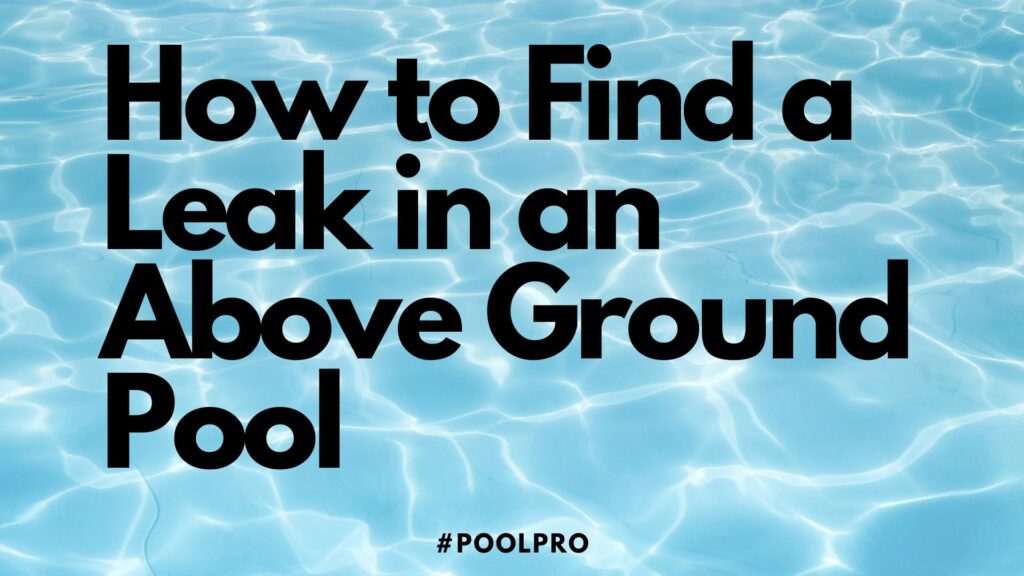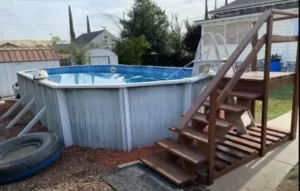Leak in Above Ground Pool – Having an above ground pool can be a fantastic addition to any backyard, providing a refreshing oasis for relaxation and fun. However, a common challenge that pool owners may face is dealing with leaks.
A leak in an above ground pool can not only lead to water loss but also cause damage to the pool structure. In this article, we will guide you through the process of identifying and locating leaks in an above ground pool, enabling you to take the necessary steps to fix them promptly.

Contents
1. Signs of Leak in Above Ground Pool
Before embarking on the journey of finding a leak, it’s essential to be aware of the signs that may indicate a leak in your above ground pool. These signs include:
- Gradual or sudden water level decrease
- Excessive water usage
- Uneven water level
- Unexplained wet spots around the pool area
- A constantly running pool pump
2. Gathering the Necessary Tools
To effectively locate a Leak in Above Ground Pool , you will need a few tools at your disposal. These tools include:
- Pool leak detection kit
- Dye or food coloring
- Bucket
- Screwdriver
- Patching material
- Underwater adhesive
3. Inspecting the Pool Surface
Begin your leak-finding journey by thoroughly inspecting the pool surface. Look for any visible cracks, holes, or tears in the pool liner.
Pay close attention to areas around the skimmer, return jets, and ladder connection points, as these are common areas for leaks to occur.
Read Also : DIY Underground Water Leak Detector
4. Checking the Pool Equipment
Next, inspect the pool equipment, such as the filter, pump, and valves. Check for any signs of leaks or drips. Tighten any loose connections and replace faulty seals or gaskets if necessary.
5. Examining the Pool Plumbing
Carefully examine the pool plumbing for potential leaks. Check the pipes, fittings, and connectors for any signs of moisture or dripping water. Repair or replace any damaged components as needed.
6. Using Dye Testing
Dye testing is a simple yet effective method to identify leaks in your above ground pool. Add a few drops of dye or food coloring near suspected leak areas, such as cracks or seams. Observe if the dye gets pulled into the pool, indicating the presence of a leak.
7. Conducting a Bucket Test
A bucket test can help determine if the water loss is due to evaporation or a leak. Fill a bucket with water, marking the water level on both the inside and outside of the bucket. Place the bucket on the pool steps or ledge, ensuring it is immersed in the water. Monitor the water levels inside and outside the bucket over 24 hours. If the water level inside the bucket decreases more than the pool’s water level, it suggests a leak.
8. Investigating Potential Structural Issues
Inspect the pool’s structural components, including the walls, seams, and joints. Look for any signs of damage, rust, or deterioration. These issues could potentially lead to leaks. If identified, promptly address them with appropriate repairs or replacements.
9. Addressing Common Leak Areas
Certain areas in an above ground pool are more prone to leaks. These areas include the skimmer, return jets, pool lights, and vinyl liner seams. Thoroughly inspect these areas for any signs of leaks and take necessary steps to fix them.
10. Repairing Minor Leaks in above ground pool
If you have identified a minor leak in your above ground pool, you can attempt to fix it yourself. Clean and dry the affected area, and apply a suitable underwater adhesive or patching material according to the manufacturer’s instructions. Ensure a proper seal to prevent further leakage.
11. Seeking Professional Assistance
For significant leaks or if you are unable to locate the source of the leak, it is advisable to seek professional assistance. Pool leak detection experts have specialized equipment and expertise to identify and fix complex leaks, ensuring a thorough and effective solution.
12. Preventing Pool Leaks
Prevention is key when it comes to pool leaks. Follow these preventive measures to minimize the risk of leak in above ground pool-
- Regularly inspect and maintain the pool equipment
- Maintain proper water chemistry and balance
- Avoid excessive water pressure in the plumbing system
- Promptly address any signs of damage or deterioration
13. Maintaining the Pool
Regular pool maintenance plays a crucial role in preventing leaks and ensuring the longevity of your above ground pool. Follow a consistent maintenance routine, including cleaning, water testing, and filter maintenance, to keep your pool in optimal condition.
Conclusion
Finding a leak in above ground pool can be a daunting task, but with the right approach and tools, you can successfully locate and address the issue. By understanding the signs of a pool leak, conducting thorough inspections, and following appropriate repair methods, you can enjoy a leak-free and enjoyable pool experience for years to come.
Frequently Asked Questions (FAQs)
[ Leak in Above Ground Pool]
Can evaporation be mistaken for a pool leak?
Yes, evaporation can sometimes be mistaken for a pool leak. Conducting a bucket test can help differentiate between the two.
How often should I inspect my above ground pool for leaks?
It is advisable to inspect your above ground pool for leaks at least once a month, especially during the pool season.
What should I do if I can’t find the source of the pool leak?
If you are unable to locate the source of the pool leak, it is recommended to seek professional assistance from a pool leak detection specialist.
Can I use regular glue to fix a pool leak?
No, regular glue is not suitable for fixing pool leaks. Use underwater adhesive or patching material specifically designed for pool repairs.
Are pool leaks covered by insurance?
Pool leaks may or may not be covered by insurance, depending on the policy. Review your insurance coverage or consult with your insurance provider for more information.

My name is James A. Bright, and I have worked in the pool and plumbing industries for over 15 years. I started poolprosoutions.com to share my experience with you guys. Here, I provide helpful guides and tips related to pool care, hot tub care, underground water leaks, and pipe leaks.



